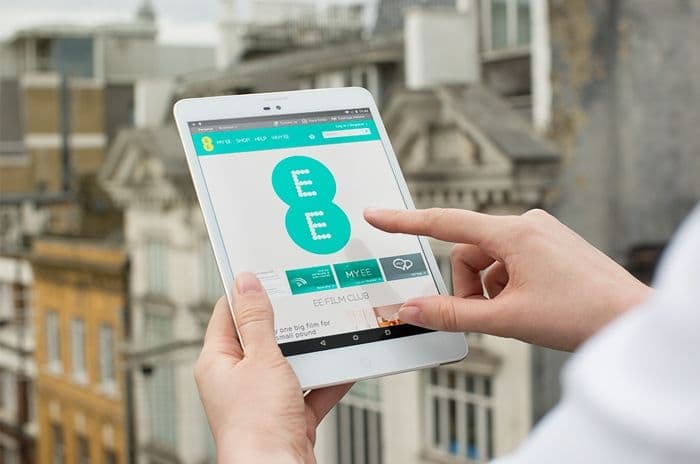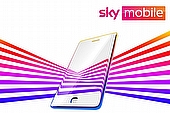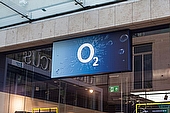| Overall Winner | EE | Compare EE deals >> |
|---|---|---|
| Tariffs & handsets | Three | |
| Price | Three | |
| Coverage | EE | |
| Speed | EE | |
| Extras | EE | |
| Customer Service | EE |
EE has better coverage, faster 4G and 5G services and a range of extras customers can add to their plans.
On the other hand, Three is all about value and they triumph over EE on price for every type of tariff.
If the decision is down to price alone, customers should opt for Three, but EE have too much going for them to ignore.

At a glance
| Three | EE | |
|---|---|---|
| Prices from | £5 | £14 |
| Length of contract | 30 days - 24 months | 24 months |
| Speeds | Average 19Mb | Average 39Mb |
| Unlimited data? | Yes | Yes |
| Coverage (population) | 99% (4G) | 99% (4G) |
| Customer satisfaction | 86% | 92% |
Call plans
Winner: Three. In every instance, Three are more generous with the data allowance for the amount of money paid.
Both EE and Three offer pay monthly SIM only deals and a form of pay as you go (PAYG) deal too.
Customers generally get cheaper deals on Three, with more generous data allowances to choose from.
It's also worth noting that Three allow customers more choice when it comes to the data tariff they want and how long they want the contract to last for.
Pay monthly
Winner: Three's data deals are cheaper and they offer more contract choice.
EE only offers SIM only deals on 24-month contracts, so there are no shorter options for customers to take advantage of if they don't want to be locked into a 24-month deal.
Here is a selection of their 24-month SIM only plans compared with those offered by Three:.
| Package | Minutes | Data | Contract term | Monthly price | ||
|---|---|---|---|---|---|---|
| Three | 1GB data | Unlimited | 1GB | 24 months | £5 | Get deal |
| EE | 1GB data | Unlimited | 1GB | 24 months | £14 | Get deal |
| Three | 100GB data | Unlimited | 100GB | 24 months | £16 | Get deal |
| EE | 120GB 5G data | Unlimited | 120GB | 24 months | £20 | Get deal |
| Three | Unlimited data | Unlimited | Unlimited | 24 months | £20 | Get deal |
| EE | Unlimited 5G data | Unlimited | Unlimited | 24 months | £35 | Get deal |
Even taking into account any special offers the providers may have on at a given time, Three's SIM only deals are substantially cheaper than EE's at every level.
Plus, while EE tariffs jump up quickly to large data plans of 100GB and higher, Three have more options for customers in the middle ground.
As we've already mentioned, EE don't offer shorter SIM only deals but Three provides customers with 12-month or 1-month deals.
Here's how their unlimited data looks on those plans:
| Package | Minutes | Data | Contract term | Monthly price | ||
|---|---|---|---|---|---|---|
| Three | Unlimited data | Unlimited | Unlimited | 12 months | £20 | Get deal |
| Three | Unlimited data | Unlimited | Unlimited | 1 month | £26 | Get deal |
There isn't a major leap in pricing, though customers will pay a premium for taking a rolling 1-month deal as we'd expect.
These prices are still likely to be cheaper than EE, however.
Pay as you go
Winner: Three's PAYG deals are cheaper and they offer unlimited data.
Traditional pay as you go (PAYG) isn't as popular with mobile networks or customers as it used to be, so the offers by EE and Three have shrunk in recent years.
The deals below allow customers to purchase a set amount of data, minutes and texts outright.
Here are EE and Three's pay as you go SIM deals side-by-side:
| Package | Minutes | Data | Contract term | Monthly price | ||
|---|---|---|---|---|---|---|
| Three | 12GB data PAYG | Unlimited | 12GB | PAYG | £10 | Get deal |
| EE | £10 Jam-packed PAYG | 500 minutes Unlimited texts | 5GB | PAYG | £10 | Get deal |
| Three | 30GB data PAYG | Unlimited | 30GB | PAYG | £15 | Get deal |
| EE | £15 Jam-packed PAYG | Unlimited | 15GB | PAYG | £15 | Get deal |
| Three | 50GB data PAYG | Unlimited | 50GB | PAYG | £20 | Get deal |
| EE | £20 Jam-packed PAYG | Unlimited | 30GB | PAYG | £20 | Get deal |
| EE | £30 Jam-packed PAYG | Unlimited | 100GB | PAYG | £30 | Get deal |
| Three | Unlimited data PAYG | Unlimited | Unlimited | PAYG | £35 | Get deal |
Although the pricing of PAYG deals between the two networks is similar, it's clear Three offer more generous data allowances for the same money.
Plus, EE cap their PAYG data options at 100GB while Three offer unlimited data.
One thing that EE has that Three doesn't is data rollover: if a customer doesn't use their data allowance within their 30 days, it will roll over to the next PAYG plan they purchase.
It's worth bearing in mind this can only happen once (so rollover data can't be accumulated like a lottery jackpot), but it may make PAYG customers more willing to choose EE despite their lower data plans.
Roaming
Winner: Three offer free roaming, although there is a data cap.
Three were one of the first mobile operators to introduce free roaming facilities, and they are still one of the most generous out there. Go Roam Around the World is now available in 71 destinations, meaning you can use up to 12GB data plus all minutes and texts included in your package without incurring any charges.
Go Roam is split into two tiers: Go Roam in Europe and Go Roam Around the World. There are different restrictions, especially on tethering, and Three also offer a Data Passport for those who want to undertake more data-heavy tasks.
EE caused a stir when they became the first mobile network to massively change their roaming policies post-Brexit.
From January 2022, customers will be charged £2 per day for using their mobile allowance in 47 European destinations. There are also options for buying 30-day passes.
When it comes to roaming, then, Three have the edge thanks to their free roaming in 71 global locations, although there are caveats attached and customers may find themselves opting for the Data Passport sometimes instead.
Handsets
Winner: Three. The network offers cheaper tariffs on our test handsets, but customers may pay slightly more upfront.
Both EE and Three offer numerous models of smartphone, from the flagship iPhones to budget friendly devices. Neither offer a separate costing for the phone and contract, which makes it difficult to understand what they are charging for handsets.
We've compared some of the offers for the most popular phones on the market currently to get an idea of which network offers best value for money.
Popular handset examples:
| Handset | Minutes | Data | Initial price | Monthly price | ||
|---|---|---|---|---|---|---|
| EE | Google Pixel 4a (128GB) | Unlimited | Unlimited | Free | £42 24 month term |
Get deal |
| Three | Google Pixel 4a (128GB) | Unlimited | Unlimited | £29 | £34 24 month term |
Get deal |
| EE | Oppo Find X3 Neo (256GB) | Unlimited | Unlimited | £10 | £52 24 month term |
Get deal |
| Three | Oppo Find X3 Neo (256GB) | Unlimited | Unlimited | £19 | £45 24 month term |
Get deal |
| EE | Apple iPhone 12 Mini (64GB) | Unlimited | Unlimited | £30 | £50 24 month term |
Get deal |
| Three | Apple iPhone 12 Mini (64GB) | Unlimited | Unlimited | £29 | £42 24 month term |
Get deal |
For simplicity, we've looked just at the unlimited data options available on these devices, but smaller data plans are available and mirror the pattern we see above.
Three offer unlimited data tariffs on these example handsets at a cheaper monthly rate than EE.
Set-up fees vary a little between handsets, though Three customers may pay slightly more upfront sometimes. That'll be more than offset by the savings during the contract if a customer chooses Three.
Read more about the cheapest mobile phone deals and where to get them.
Handset choice
Winner: Three seem to have a wider variety of handsets available.
Although both networks do offer a wide range of handsets, the options available may well be different and customers with their heart set on a specific model may have to choose one network or the other based on handset choice.
As a snapshot, at the time of writing, the networks had devices from the following manufacturers available:
| EE | Three |
|---|---|
| Apple | Apple |
| Samsung | Samsung |
| Oppo | Oppo |
| Huawei | Huawei |
| Motorola | OnePlus |
| Sony | TCL |
| Doro | Xiaomi |
| Nokia | |
| Alcatel |
This list isn't a permanent one and contracts between manufacturers and networks change as new handsets are released.
Yet it's striking that Three not only offer more device choice, they also provide pay monthly deals on some decidedly budget handsets from Nokia and Alcatel, whereas the closest EE have is Doro, a brand for older mobile phone users.
Price
Winner: Three win at every level if we're thinking about price alone.
There's one common thread running through all the tables above: Three is a cheaper option than EE on pay monthly SIM only deals, PAYG plans and handset packages too.
Plus, Three's decision to maintain free roaming adds an extra layer to their services that EE has opted out of matching.
If the choice was on price alone, Three would be the undisputed winner, but there are other key considerations that may affect which network a customer chooses.
Coverage
Winner: EE. Although both networks claim to reach 99% of the population, EE's geographical coverage with 4G services just gives them the edge.
As a network made up of two former networks (Orange and T-Mobile) it's no great surprise that EE have the best coverage of pretty much any network in the UK. Adopting the infrastructure from these two companies has given them a head start on other operators.
After being bought out by BT in 2016, EE were able to utilise the extensive BT network of fibre optic cables to extend their coverage. This means that now EE cover 99% of the UK population with 4G services, yet their landmass coverage has only just passed the 85% mark, despite pledges to make it to 95% by 2020.
Three don't do at all badly though, considering the competitive advantage EE have had. 4G coverage by Three is also at 99% of the population, thanks to their efforts to double their network in size over the past decade.
Yet Three's 4G landmass coverage according to Ofcom's 2020 Connected Nations report is the lowest of all four operators at 79%.
If we look at the number of indoor premises covered by the two operators, EE is at 93% and Three is at 90%.
For customers in affected areas, Three's lower coverage levels could be a real problem.
In terms of the frequencies used, EE has access to 800MHz, 1800MHz, 2100MHz, 2600MHz and 3400MHz (5G). Three use all of these except the 2600MHz band, but they also have access to the 1400MHz 4G band and the 3600-4000MHz 5G band. As the 2600MHz band is the one most likely to provide fast speeds in densely populated areas, EE are likely to be more reliable than Three in city situations.
There's more information in our guide to mobile network coverage in the UK.
5G coverage
Winner: EE have rolled out 5G to more locations so far.
5G coverage is expanding rapidly and both networks are rolling the service out to parts of more towns and cities every week.
Currently, EE claim they have 5G active in 160 towns and cities across the UK while Three say they have over 300 active 5G locations across 100 towns and cities.
So, EE have the lead on 5G coverage, but it's important to note that simply having a 5G presence in an area doesn't mean coverage will be universal across that town.
Read more about mobile networks and 5G broadband.
Speeds
Winner: EE. They are a faster network overall, with 4G speeds that Three just can't keep up with.
EE often shout about their super-fast 4G speeds, but are they really any faster than Three? Research conducted by Opensignal found that, actually, they are. Here are the test results from April 2021 for you to compare:
| EE | Three | |
|---|---|---|
| Download Speed Experience | 39Mbps | 19.3Mbps |
| Upload Speed Experience | 9.1Mbps | 6.8Mbps |
Clearly, the faster network of the two is EE. On 4G technology, they offer downloads of a massive 20Mbps faster than Three. This is backed up by data from other sources such as Tutela and RootMetrics.
On 5G, research from RootMetrics showed EE had consistent speeds of more than 100GB in all 16 test cities, while Three could only manage that level in 7.
This data should be treated with caution as it's a snapshot of speeds in large cities rather than across the 5G network as a whole. Yet it does indicate EE's early 5G deployment is making a difference and, after a good start, Three has been left needing to play catch-up.
Extras
Winner: EE have more upgrades on offer than Three.
EE offers customers the chance to sign up for Smart Plans which include swappable benefits.
These plans are more expensive than basic plans as we'd expect and the benefits change depending on which partnerships EE has at the time and which extra services they're trying to push.
At the time of writing, all customers can choose from the following Smart Benefits:
- Apple Music
- Netflix
- BT Sport Ultimate
- Video Data Pass
- Roam Abroad
EE also offer a Full Works plan especially for Apple iPhone users. Customers can choose from these Smart Benefits on Full Works:
- Apple Music
- Apple TV+
- BT Sport Ultimate
- Apple Arcade
- Video Data Pass
- Roam Abroad
These can be useful for customers, but it's always worth checking whether the services are cheaper taken independently.
Something else offered by EE to all their pay monthly customers is their Stay Connected service.
This allows customers to access speeds of up to 0.5Mbps even when their data allowance has run out for the month. It isn't very fast but it's better than being without data.
On the other hand, Three have refocused on their core offer as a budget-friendly mobile provider.
We've discussed their Go Roam service, but that's the main perk customers will get from signing up to Three since they scrapped their Go Binge service in late 2020.
Customer service
Winner: EE have higher levels of satisfaction and lower levels of complaints.
EE might not have had the best historic reputation for customer service, but they have really turned things around and frequently rank highly in customer service figures.
Ofcom's 2020 Comparing Service Quality report shows how both networks are performing on customer service:
| EE | Three | |
|---|---|---|
| Satisfaction with service overall | 92% | 86% |
| Satisfaction with value for money | 80% | 88% |
| Customers with a reason to complain | 9% | 13% |
| Overall satisfaction with complaints handling | 56% | 56% |
| Number of complaints per 100,000 customers (2020) | 6 | 23 |
| Average call waiting time | 2 minutes 9 seconds | 1 minute 3 seconds |
As well as substantially lower levels of complaints, EE were above the industry average for overall service satisfaction while Three were singled out by Ofcom as performing poorly.
Three also had more customers with a reason to complain in 2020, whether they did so or not.
One area where Three shine, though, is value for money. That's indicative of everything we've covered throughout this comparative guide: Three's value for money is better than EE's, but they fall short on other elements.
Read more about how each mobile network performs for customer service here.
Verdict: Who is the best mobile provider, Three or EE?
While both networks have a lot going for them, we do have to pick a favourite, which is not an easy task. Both offer good coverage, and the advantages EE has in speed are made up for by Three in terms of their great value deals and unlimited data offers.
Overall winner: EE. For us, the outstanding customer service offered by EE is what will sway our decision. Although you may pay a little more for your data and phone, we think having the surety of a great connection across the UK, as well as excellent customer support when its needed, makes EE our top choice.
Of course, the decision on which is the right network for you will depend on your priorities. Those looking for huge data allowances can't go wrong with Three, particularly since they removed the cap on their hotspot usage in 2018.
Equally, customers looking to bundle extra services within their mobile phone contract may be attracted by the Smart Plans offered by EE,
More information on both networks are available in our guide to EE here and our guide to Three here.








Comments